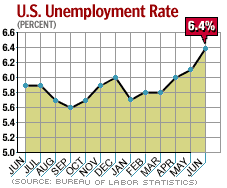NEW YORK (CNN/Money) -
The U.S. economy may have posted stronger-than-expected growth in the second quarter, but that doesn't necessarily mean Friday's jobs report will be very good.
In fact, some economists think it could be several months before an economic rebound starts to boost the labor market, which has been mired in its longest slump since World War II.
Second-quarter gross domestic product (GDP), the broadest measure of the nation's economy, grew at an annual 2.4 percent rate, the Commerce Department said Thursday, surprising most economists, who expected a reading of about 1.5 percent, on average.

The GDP number came a day before the Labor Department is scheduled to announce the unemployment rate and change in payrolls in July. Economists polled by Reuters, on average, figure unemployment fell to 6.3 percent this month from 6.4 percent in June, while employers outside the farm sector added 18,000 jobs after cutting 30,000 jobs in June.
If the better-than-expected GDP report and surprisingly low numbers of new weekly jobless claims in the past two weeks have you panting for another pleasant surprise in the jobs report Friday, well ... don't hold your breath.
"You can't read this [GDP] report and expect it to translate into a good report tomorrow," said Josh Bivens, an economist at the Economic Policy Institute, a non-profit research group in Washington. "Employment is a lagging indicator, so it will be at least two quarters, or maybe even four quarters, before better growth numbers translate into better jobs numbers."
As for the weekly jobless claims, those have been skewed this month by seasonal factors such as annual auto-plant shut-downs. In addition, the Labor Department's survey for Friday's unemployment report ended in mid-July -- before the most recent jobless claims were tallied.
Hopeful signs for the near future
Certainly, there were some hopeful signs for the labor market in Thursday's economic reports.
| Related stories
|

|
|
|
|
Most importantly, a big drop in inventories in the GDP report raised hopes that businesses will be forced to boost production in the future to meet higher demand.
Typically, skittish company executives hold off on boosting production until they're sure demand has picked up. Meanwhile, early gains in sales eat away at their inventories. Eventually, in order to keep up with demand, they have to start making stuff faster -- and, hopefully, hire people.
"Today's numbers are pointing toward a considerable improvement in manufacturing activity in the second half of the year," said David Resler, chief economist at Nomura Securities. "Inventories are so lean that I can't imagine businesses have enough left to satisfy much of the demand. There's got to be more production."
Resler also pointed out that recent regional measures of manufacturing activity, including Thursday's better-than-expected Chicago purchasing managers' index -- have shown positive swings in their measures of employment.
Other economists worry, though, that the usual business cycle has been altered enough so that sinking inventories do not guarantee higher production to come.
| 
| |

| 
| 
|

|
 CNNfn's Gerri Willis takes a look at the states where unemployment is at the highest level. CNNfn's Gerri Willis takes a look at the states where unemployment is at the highest level.
|
|
 Play video
Play video
(Real or Windows Media)
|
| 
|

|
|
For one thing, companies are using technology to keep much tighter control of their inventories. The late-'90s boom helped companies see how profitable just-in-time business practices could be, and they haven't forgotten that lesson.
And many companies are now producing goods overseas, so that this quarter's declines in inventories might be made up by factories in China, India, the Philippines or other low-cost markets, rather than plants in the United States.
"$11 billion of the $18 billion drop in inventories was in manufacturing, and there's an element of that which isn't a matter of U.S. factories humming along [to re-stock shelves]," said David Kelly, economist at Putnam Investments. "In many cases, there simply isn't any U.S. factory any more, and some of this may be just a permanent reduction in inventories."
Help-wanted index rises
More encouraging news may have come from the monthly Help Wanted Index, compiled by the Conference Board, the same private research group that tracks the closely watched consumer confidence surveys.
The index, which tracks help-wanted advertising in 51 U.S. newspapers, rose a bit in May, but more important was the fact that help-wanted ad volume jumped in 73 percent of all U.S. markets, the highest rate since December 2001.
On the other hand, help-wanted ad volume overall still was lower than it was in January -- when businesses had the war in Iraq to worry about -- and far lower than it was a year ago, indicating labor demand still is not robust.
And details in the GDP report threw some cold water on the notion of higher demand boosting hiring, since most of the economy's growth was in defense spending and sales of durable goods -- automobiles, mainly. The service and non-durable goods sectors of the economy, which make up most of consumer spending, were relatively weak.
"What bothers me most in terms of job growth is the GDP number itself -- when you look at it, it got a lot of strength from the government sector and the auto sector, but beyond that, consumer spending on services was weak," said Robert Brusca, chief economist at Native American Securities in New York. "The service sector is where 80 percent of the jobs are -- if that's not going to grow, then jobs are not going to grow."

|

